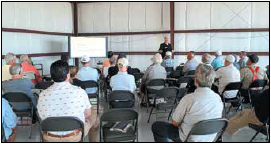Recently I attended a Rusty Pilot session and learned (or re-learned as the case may be) several aspects of our aviating world that laid dormant in my little gray cells for far too long. Although I have been an active presenter of this constructive AOPA educational series for three years, it has been on hold for the past two years and is now being revived.
My ears perked up when the presenter mentioned that AOPA wants to expand the Rusty Pilot concept to the instrument environment with an IFR refresher program. Of course, the “blind flying” group (as we were called in the early days) has had a monthly forum in many parts of the country for over a decade with the EAA sponsored IMC Club. (https://www.eaa.org/IMC). The referenced website can provide the location of a club near you and their meeting time and place. With the advent of the coronavirus, many chapters have been using video conferencing on the internet to continue their sessions.
I had been a regular in Albuquerque but hadn’t followed up after moving to Florida last year. Being on their e-mail notification list, I continue to receive a reminder of their meetings held the third Saturday of each month—and I attended a session via Zoom.
Typically, each monthly gathering consists of a scenario based on the real-world encounter of a member using a brief but well-laid-out PowerPoint presentation by the local moderator (usually a CFII). First, the aircraft type and equipment are provided, along with the route and weather conditions. Then “a problem” is introduced, and the group works the flight through by proposing and examining the various alternatives.
Discussion often ranges through the entire spectrum of weather, regulations, airspace knowledge, aircraft capabilities, and of course, pilot skills. There was a lot of dialogue that allowed me to internalize much of the topic over the 90 minutes of this meeting. Although there is still no substitute for actual stick time, these gatherings certainly refresh my storehouse of knowledge.
While the pilot’s actions and the outcome of the flight are usually not revealed, this often adds more intensity to the discussion. A series of four to six multiple-choice questions is also provided at the end that allows the moderator to explore various aspects of the IFR setting, such as components of an approach chart.
Flight in IMC is one of the most critical activities we can undertake. It requires constant vigilance in knowledge and skills. These types of sessions can provide an awareness of our own reactions to changing conditions and their impact on our thinking process. Expanding our exposure to the experiences of others helps keep us alert to the possible options available.
In today’s world of instrument flying, academics often become an overriding factor with the complex airspace, high-tech avionics, and convoluted regulations. Unless you fly several times a week in the system and encounter and effectively handle the many aspects of being on the gauges, it’s challenging to stay abreast of its intricacies. Yet, this kind of ground activity is the next best thing to actually being there and doing it—and it costs a lot less.





